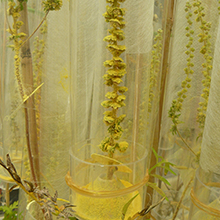

Air pollution increases allergenicity of Ambrosia pollen (yellow)
Source: Helmholtz Zentrum München (HMGU)
Together with the Research Unit Protein Science and the Institute for Environmental Medicine of Technische Universität München as well as the research consortium UNIKA-T and the Christine Kühne – Center for Allergy Research and Education, researchers of the Institute of Biochemical Plant Pathology (BIOP) studied how nitrogen oxides affect the pollen of the plant.
Specifically, they fumigated the plants with various concentrations of NO2, which e.g. is generated during combustion processes of fuel. “Our data showed that the stress on the plant caused by NO2 modulated the protein composition of the pollen,” said first author Dr. Feng Zhao.
“Different isoforms of the known allergen Amb a 1 were significantly elevated.” In addition, the scientists observed that the pollen from NO2 treated plants have a significantly increased binding capacity to specific IgE antibodies* of individuals allergic to Ambrosia. This is often the beginning of an allergic reaction in humans.
Previously unknown allergen in Ambrosia
The plant researchers made another striking discovery in the pollen of the fumigated plants: During their investigations they identified a protein that was present in particular when NO2 levels were elevated. This protein was not previously known to be an allergen in Ambrosia, and it has a strong similarity with a protein from a rubber tree. In this context, it was previously described as an allergen whose effect was also known in fungi and other plants. Further experiments related to this topic are currently being planned.
Stress makes pollen aggressive
“Ultimately, it can be expected that the already aggressive Ambrosia pollen will become even more allergenic in the future due to air pollution,” said study leader Dr. Ulrike Frank, summarizing the results. She and her team at BIOP have long been conducting research on the plant, which probably once came to Europe in imported birdseed. Now it is widely dispersed here due to climate change. Ragweed pollen is very aggressive; in the U.S. it is now the main cause of hay fever and other allergies. Since Ambrosia does not bloom until late summer, it thus lengthens the “season” for allergy sufferers.
“After studies have already shown that Ambrosia growing along highways is clearly more allergenic than Ambrosia plants growing away from road traffic, we could provide a reason for this,” said Frank. “Since in nature and along roads hundreds of parameters could play a role, until now the situation was not entirely clear.” In future studies in collaboration with UNIKA-T and the Christine Kühne – Center for Allergy Research and Education, the scientists want to show that pollen only treated with NO2 can also elicit stronger in vivo reactions.
Further Information
Background:
* IgE (Immunglobulin E) is the term referring to a class of antibodies which are considered to be the main cause of allergic reactions in the body. If an IgE molecule binds to an allergen, it can induce so-called mast cells to release histamine, which ultimately triggers the allergic reaction. The actual task of IgE is the defense against parasites and worms.
Original Publication:
Zhao, F. et al. (2015). Common ragweed (Ambrosia artemisiifolia L.): Allergenicity and molecular characterisation of pollen after plant exposure to elevated NO2. Plant, Cell & Environment, DOI: 10.1111/pce.12601
As German Research Center for Environmental Health, Helmholtz Zentrum München pursues the goal of developing personalized medical approaches for the prevention and therapy of major common diseases such as diabetes mellitus and lung diseases. To achieve this, it investigates the interaction of genetics, environmental factors and lifestyle. The Helmholtz Zentrum München has about 2,300 staff members and is headquartered in Neuherberg in the north of Munich. Helmholtz Zentrum München is a member of the Helmholtz Association, a community of 18 scientific-technical and medical-biological research centers with a total of about 37,000 staff members.
The focal point of the research work carried out by the Institute of Biochemical Plant Pathology is the examination of molecular mechanisms that plants use to adapt to their environment. These include genetic and biochemical processes which control the growth, physiological state and defence mechanisms of the plants. The aim of the research is to better understand the fundamental principles and mechanisms of the interaction between plants and their environment and to develop sustainable strategies for the cultivation and use of plants to protect natural resources.
Contact for the media:
Department of Communication, Helmholtz Zentrum München – German Research Center for Environmental Health (GmbH), Ingolstädter Landstr. 1, 85764 Neuherberg – Phone: +49 89 3187 2238 – Fax: +49 89 3187 3324 – E-mail: presse@helmholtz-muenchen.de
Scientific contact at Helmholtz Zentrum München:
Dr. Ulrike Frank, Helmholtz Zentrum München – German Research Center for Environmental Health (GmbH), Institute of Biochemical Plant Pathology, Ingolstädter Landstr. 1, 85764 Neuherberg – Phone: +49 89 3187 2422 – E-mail: ulrike.frank@helmholtz-muenchen.de
http://www.ncbi.nlm.nih.gov/pubmed/26177592 – Link to the Publication
http://www.helmholtz-muenchen.de/en/news/press-releases/2015/index.html – Press releases Helmholtz Zentrum München
http://www.helmholtz-muenchen.de/biop – Institute of Biochemical Plant Pathology












